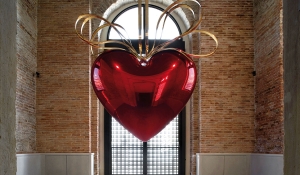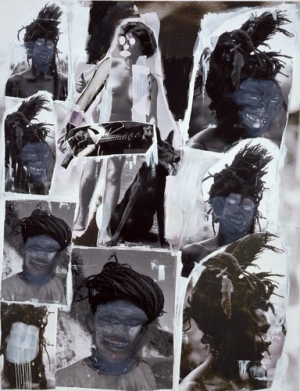|
Displaying items by tag: Richard Prince

Los Angeles certainly knows how to throw a party. But never is it more obvious than in the week leading up to the Academy Awards, when its party-throwing prowess is on full display. There are soirées by "Vanity Fair," the Weinstein Company, and Bulgari—one can easily find herself invited to four or more fêtes in one evening alone. The art world of LA is no exception; in fact, why wouldn't dealers capitalize on the likelihood of having Sir Elton John or Ingrid Sischy swing by, say hello, and support an opening night shindig even if only for a 15-minute drive-by en route to another celebration?
Gagosian Gallery is the master at availing itself of the big guns visiting LA during this high-flown week; the last four years, the art world monolith has brought forth fantastical openings by Urs Fischer, Richard Prince, and Taryn Simon (also known in LA environs as Gwyneth's sister-in-law). This year, Gagosian gives us figurative painter John Currin, opening Thursday, February 19, with his first solo show in LA in nearly a decade.
Mead Carney, the contemporary art space and advisory firm founded by Nigel Mead in London in 2012, is the first commercial gallery to open in Porto Montenegro, which has been dubbed “the Monte Carlo of the Adriatic”. This month the gallery launched with the exhibition, “The Shock of the New” (until 30 September), which includes work by Damien Hirst, Gerhard Richter and Richard Prince.
The Adriatic Sea port, a tax-friendly destination and the home port of choice for many super-yacht owners, is in the Bay of Kotor, which is a Unesco World Heritage site.

The Grimaldi Forum in Monaco, France, is currently hosting the exhibition “ArtLovers: Stories of Art in the Pinault Collection.” The show features forty works from François Pinault’s illustrious collection, including more than a third that have never been displayed in previous exhibitions of the Collection. Thirty-three artists, including Maurizio Cattelan, Urs Fischer, Dan Flavin, Damien Hirst, Jeff Koons, Paul McCarthy, Takashi Murakami, Richard Prince, and Rachel Whiteread will be represented.
The Pinault Collection, which features paintings, sculptures, installations, video, drawings, and more, was assembled by the French businessman François Pinault. Pinault is the founder of the holding company Artemis S.A., which owns Christie’s auction house as well as a number of luxury brands. Pinault currently owns one of the biggest collections of contemporary art worldwide and in 2006, he acquired Venice’s Palazzo Grassi Punta della Dogana to display his collection. The exhibition at the Grimaldi Forum was curated by Martin Bethenod, the Director of the Palazzo Grassi.
Christie’s sold $134.6 million of contemporary art in New York in an hour as international buyers from 26 countries chased after works including Andy Warhol’s electric chair silkscreen and Martin Kippenberger’s slouching man in his underwear.
Titled “If I Live I’ll See You Tuesday,” the auction yesterday surpassed its high target of $124.1 million as 11 artist records were set, including those for Richard Prince, On Kawara, Wade Guyton, Dan Colen and Kippenberger. Of the 35 lots offered, all but one found buyers. Similar to last week’s Impressionist and modern art auctions, Asian collectors competed fiercely, winning at least two of the top 10 lots, Christie’s said.
After closing his firm Exis Capital Management Inc., hedge-fund manager Adam Sender announced that he will sell nearly half of his contemporary art collection at Sotheby’s. Since 1998, with guidance from New York-based art adviser Todd Levin and various Chelsea gallerists, Sender has amassed a collection of approximately 800 works by 139 artists.
Over the course of 18 months, Sotheby’s will sell about 400 works from Sender’s collection, including pieces by Cindy Sherman, Richard Prince, John Baldessari and Dan Flavin. The collection is expected to fetch over $70 million.
The first selection of works from Sender’s collection will be offered on May 14 at Sotheby’s important evening sale of contemporary art.

Peter Brant, chairman and chief executive officer of the White Birch Paper Co., has fallen from billionaire status and is turning to his contemporary art collection to help recapitalize the family newsprint business. An early patron of Andy Warhol, Brant recently pledged 56 works to the lending arm of Sotheby’s including works by Warhol, Richard Prince, and Jean-Michel Basquiat. Brant also pledged pieces to a unit of the Deutsche Bank AG and his former business partner, including a Warhol from the early 1960s that is said to be worth around $35 million.
Ranked as one of the largest contemporary art collectors in the United States, Brant joins a number of wealthy collectors who have started taking out loans backed artworks to fund their ventures. It is rumored that Brant used his art collection to provide some of the capital needed to buy White Birch out of bankruptcy in 2011.
According to an annual report, Sotheby’s Financial Services provides consignment loans secured by artworks that borrowers have agreed to sell through the auction house, permitting them to get some of the proceeds as much as a year ahead of time. The auction house also makes term loans on works that clients aren’t planning to sell in order to solidify relationships with borrowers that will hopefully lead to future consignments.

ONE recent afternoon in the offices of the Midtown law firm run by David Boies and his powerful litigation partners, a large black clamshell box sat on a conference table. Inside were raucous, sometimes wildly funny collages of photographs and magazine pages handmade by the artist Richard Prince, works of art that have become the ur-texts of one of the most closely watched copyright cases ever to rattle the world of fine art.
In March a federal district court judge in Manhattan ruled that Mr. Prince — whose career was built on appropriating imagery created by others — broke the law by taking photographs from a book about Rastafarians and using them without permission to create the collages and a series of paintings based on them, which quickly sold for serious money even by today’s gilded art-world standards: almost $2.5 million for one of the works. (“Wow — yeah,” Mr. Prince said when a lawyer asked him under oath in the district court case if that figure was correct.)
The decision, by Judge Deborah A. Batts, set off alarm bells throughout Chelsea and in museums across America that show contemporary art. At the heart of the case, which Mr. Prince is now appealing, is the principle called fair use, a kind of door in the bulwark of copyright protections. It gives artists (or anyone for that matter) the ability to use someone else’s material for certain purposes, especially if the result transforms the thing used — or as Judge Pierre N. Leval described it in an influential 1990 law review article, if the new thing “adds value to the original” so that society as a whole is culturally enriched by it. In the most famous test of the principle, the Supreme Court in 1994 found a possibility of fair use by the group 2 Live Crew in its sampling of parts of Roy Orbison’s “Oh Pretty Woman” for the sake of one form of added value, parody.
In the Prince case the notoriously slippery standard for transformation was defined so narrowly that artists and museums warned it would leave the fair-use door barely open, threatening the robust tradition of appropriation that goes back at least to Picasso and underpins much of the art of the last half-century. Several museums, including the Museum of Modern Art and the Metropolitan, rallied to the cause, filing papers supporting Mr. Prince and calling the decision a blow to “the strong public interest in the free flow of creative expression.” Scholars and lawyers on the other side of the debate hailed it instead as a welcome corrective in an art world too long in thrall to the Pictures Generation — artists like Mr. Prince who used appropriation beginning in the 1970s to burrow beneath the surface of media culture.
But if the case has had any effect so far, it has been to drag into the public arena a fundamental truth hovering somewhere just outside the legal debate: that today’s flow of creative expression, riding a tide of billions of instantly accessible digital images and clips, is rapidly becoming so free and recycling so reflexive that it is hard to imagine it being slowed, much less stanched, whatever happens in court. It is a phenomenon that makes Mr. Prince’s artful thefts — those collages in the law firm’s office — look almost Victorian by comparison, and makes the copyright battle and its attendant fears feel as if they are playing out in another era as well, perhaps not Victorian but certainly pre-Internet.
In many ways the art world is a latecomer to the kinds of copyright tensions that have already played out in fields like music and movies, where extensive systems of policing, permission and licensing have evolved. But art lawyers say that legal challenges are now coming at a faster pace, perhaps in part because the art market has become a much bigger business and because of the extent of the borrowing ethos.
Dip almost anywhere into contemporary art over the last couple of years to see the extent. The group show “Free” at the New Museum in 2010 was built partly around the very idea of the borrowing culture, the way the Web is radically reordering the concept of appropriation, with works that “lift, borrow and reframe digital images — not in a rebellious act of stealing or a deconstructive act of critique — but as a way to participate thoughtfully and actively in a culture that is highly circulated, hybridized, internationalized,” as its curator, Lauren Cornell, wrote.
Christian Marclay’s wildly popular video “The Clock” from 2010 was 24 hours of appropriation, made from thousands of stitched-together fragments from films and television shows. Rob Pruitt’s show “Pattern and Degradation” at the Gavin Brown and Maccarone galleries in 2010 lifted designs from Lilly Pulitzer, from Web photo memes and from a couple of T-shirt designers, whose angry supporters staged a flash-mob demonstration to protest the use of the design without attribution.

American artist Richard Prince has two exhibitions opening in Paris this week.
The artists’ homage to Willem de Kooning, a series of abstract expressionist-style paintings, opened at the Gagosian Gallery yesterday. While a collection of Prince’s ephemera opened at the Bibliothèque nationale de France today.
The Bibliothèque nationale show is inspired by Jim Morrison’s poem ‘An American Prayer’. It includes several of Prince’s famous “rephotographs” as well as a selection of books and snapshots, other personal items and his famous ‘Nurse’ paintings.
Despite their proximity, the contrast between the two shows could not be more obvious.
Prince’s de Kooning works are gestural, sketchy pieces combining painting and drawing with cut out images of torsos and genitalia.
“It was time to pay homage to an artist I really like,” Prince said in a statement. “Some people worship at the alter – I believe in de Kooning.”
'Richard Prince: de Kooning' is at the Gagosian Gallery until 21 May; and 'Richard Prince: American Prayer' is at the Bibliothèque nationale de France until 26 June
Click here for images from both exhibitions.
|
|
|
|
|